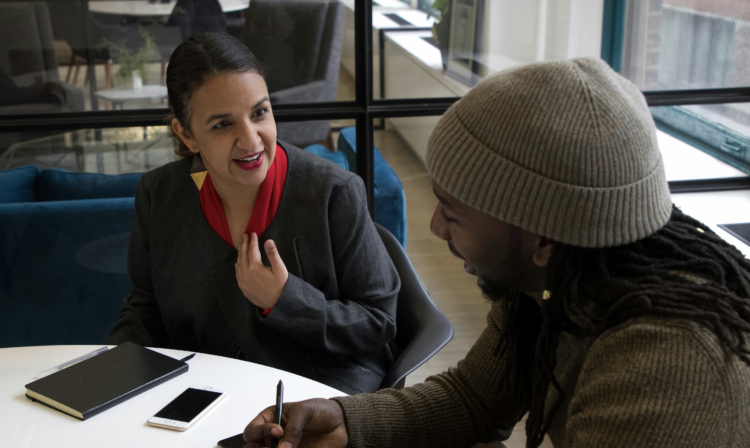Like others, my holiday shopping experience has been transformed. Back in the day, I had to fight my way through crowded stores and dig through racks, shelves, and bins that became more disorganized as the holidays approached. Then came online shopping. Stores could post products online in, but shopping there was still like looking through an online catalog. Web 2.0 changed all that. My family now creates online wishlists that tell me exactly what they want—a good thing, because how else would I know which video games my 43-year old brother versus 14-year old nephew prefer? (Dragon Age Inquisition and Far Cry 4 seem awfully similar to me.) Web 2.0 sites like Amazon, Etsy, and Zappos don’t just provide information from publishers and vendors. They allow users to share their reviews and ratings with others who, in turn, can read and respond to those posts. This type of user interaction provides valuable information: Does the product deliver on the vendor’s promises? Is it worth the price?
I’ve been reading about the evolution of the internet lately, and it has me thinking about what the next generation of evidence-based policy might look like.
Consider encyclopedias. Web 1.0 took us from hard-bound volumes of Encyclopedia Britannica to an online version. Web 2.0 gave us Wikipedia, an open access encyclopedia that enables people to post, add, contest, and suggest changes to what others have written. It harnesses what Tim O’Reilly calls “collective intelligence.” Web 1.0 provided static content. Web 2.0 promotes social interaction and engagement.
Evidence-Based Policy 2.0
The early generation of evidence-based policy (EBP) was largely about producing evidence and, like Web 1.0, disseminating information to users. The field made enormous progress in the past decade, especially around “what works” evidence. Research on effective programs is generated using more rigorous research designs. Funding for those studies has expanded through Congressional set-asides and agency investments. What Works Clearinghouses synthesize and disseminate that evidence. There are incentives to adopt programs and practices backed by research.
But increasing research rigor is not sufficient, and making that evidence available on a website won’t get it used. Users need ongoing engagement around research. Policymakers need opportunities to talk about the research and interact with others in order to apply findings. They want to talk with peers that they trust. They also benefit from interacting with researchers. This is not about disseminating research; it’s about dialogue. Policymakers will always have questions about how research applies to their local context and needs. Researchers will not always have the answers to those questions, but they can bring their broader knowledge of the research literature to the conversation. In Web 2.0, producers’ interactions with users created a more relevant internet experience. Engaging with policymakers can help researchers develop more relevant research agendas.
Web 2.0 required “trusting users as co-developers.” EBP 2.0 will as well. Knowledge does not just come from researchers, but from users. Researchers provide expertise based on theoretical models, carefully collected data, and rigorous analyses. Policymakers bring their own theories of action, experience, and judgments. For evidence-based policy to evolve, we need to find productive ways to marry these different types of policy-relevant evidence. The decision-making apparatus needs to be responsive to the needs of state and local users. Federal policymakers and researchers will need to trust those users as co-developers of knowledge.
Research-practice partnerships are promising arrangements that foster trust to promote evidence-based policy. All around the country, state and local agencies are developing long-term relationships with researchers to produce studies that meet the needs of their educational systems. They develop research agendas that fit researchers’ interests and policymakers’ needs. They collaborate to shape specific research projects. Findings are discussed as they emerge. Sometimes those conversations lead to further analyses to understand the problem; and other times they lead to tougher questions about what program, curricular, or professional development changes should be made.
Moving from Web 1.0 to 2.0 required innovative platforms. Social networks, wikis, and tagging enable online interaction. EBP 2.0 will also need an infrastructure that supports ongoing engagement between people and around research, data, and experience. Engagement will need to be fostered within agencies, across policy actors at varying levels and roles, and in the broader ecosystem including advocates, the media, and the public. Smart incentive systems, research-practice partnerships, intermediary organizations, and cross-functional agency teams can all be part of that infrastructure.
What might 3.0 look like?
Some say that Web 3.0 will be even more responsive to users. Information will be integrated for and tailored to individual users. People will no longer need to go to different sites for answers to different questions. Instead, the information will be amalgamated. And, the search results will be tailored to individuals based on their prior information needs and the contexts of their requests. Might EBP leap frog into version 3.0? If so, EBP will foster brokering; it will connect information and people in contextualized ways.
Policymakers would be able to easily access research relevant to their particular questions and local context, and they could interact with colleagues working on those same issues. A child welfare agency in one rural California county could learn from a colleague in another locality about an evidence-based practice they are considering. Someone designing ELL services in Houston might look into similar efforts in San Francisco or New York.
Of course there are risks to Web 3.0 and there will surely be for EBP as well. Personalized searches are great in some ways, but concerning in others. (I like Pandora’s music suggestions but am uncomfortable when Amazon uses my prior purchases to suggest additional ones.) Privacy concerns are a key issue that will need to be addressed in Web 3.0. In EBP 3.0, tailored searches could limit decision makers’ ability to probe unexpected sources and explore countervailing paths. These are real concerns that face any new endeavor, and we will need to smartly handle them as we move forward.
There are many innovative ideas out there about promoting evidence use in policy. I am eager to learn your ideas about the future. As you make your way through the cyber turnstiles this holiday season, think about how fostering user engagement, trusting users as co-developers, and harnessing collective intelligence might play out in evidence-based policy. Send me your ideas and let’s kickstart the next era of EBP.
Disclaimer: This blog is in no way an endorsement of Amazon, Etsy, Zappos, Wikipedia, Dragon Age Inquisition, or Far Cry 4.





